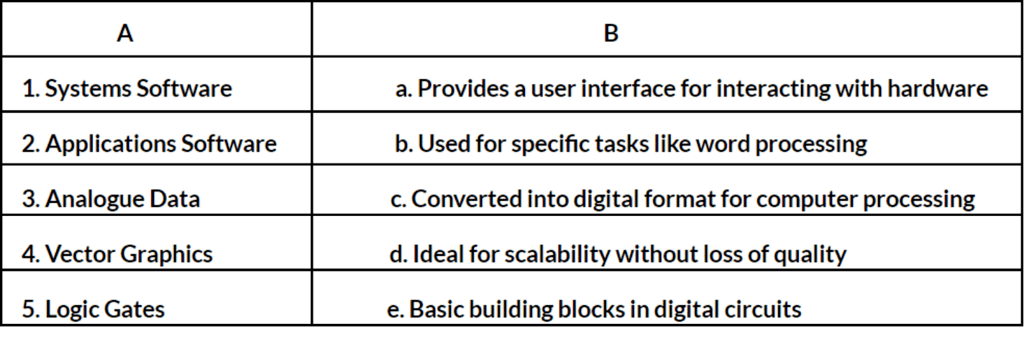Worksheet: Living with Al: Digital data | IGCSE Cambridge Computing for Year 6 - Class 6 PDF Download
| Table of contents |

|
| Multiple Choice Questions (MCQs): |

|
| Fill in the Blanks: |

|
| True/False: |

|
| Match the Following: |

|
Multiple Choice Questions (MCQs):
Q1: What is the primary function of an operating system?
A) To provide a user interface for interacting with hardware and software
B) To perform specific tasks like word processing or web browsing
C) To enhance the interaction between digital devices and users
D) To convert analogue data into digital format
Ans: A
The operating system is a crucial part of the systems software that provides a user interface for interacting with the computer's hardware and other software.
Q2: Which of the following is NOT an example of an application software?
A) Word processor
B) Web browser
C) Operating system
D) Image editor
Ans: C
An operating system like Windows or macOS is not an application software; it is a part of the systems software.
Q3: What is the primary purpose of using sensors in AI devices?
A) To convert analogue data into digital format
B) To provide input data for the AI system to process
C) To enhance the interaction between users and digital devices
D) To perform specific tasks like word processing or web browsing
Ans: B
Sensors like cameras, microphones, and proximity sensors are used in AI devices to provide input data, such as images, sound, or environmental data, for the AI system to process.
Q4: What is the primary advantage of vector graphics over bitmap images?
A) Higher resolution
B) Smaller file size
C) Greater color depth
D) Scalability without loss of quality
Ans: D
Vector graphics are ideal for scalability because they can be resized without losing quality, while bitmap images may become pixelated or blurry when scaled up.
Q5: Which type of logic gate will output a 1 only when both inputs are 1?
A) AND gate
B) OR gate
C) NOT gate
D) XOR gate
Ans: A
An AND gate will output a 1 only when both of its inputs are 1; otherwise, it will output a 0.
Fill in the Blanks:
Q1: ____________ is a technology that enables digital devices to perform tasks that typically require human intelligence.
Ans: Artificial Intelligence (AI)
Q2: ____________ graphics are composed of individual pixels arranged in a grid, with each pixel having its own color value.
Ans: Bitmap
Q3: The process of dividing an image into pixels and representing each pixel's color in binary format is called ____________.
Ans: Digitization
Q4: ____________ logic deals with conditions that can only be true or false, using operations like AND and OR.
Ans: Boolean
Q5: The ____________ gate has one input, and its output is always the opposite of the input.
Ans: NOT
True/False:
Q1: All digital devices need both systems software and applications software to function properly.
Ans: True
Digital devices require both systems software (like operating systems) and applications software (like word processors) to function correctly.
Q2: AI devices can improve their responses over time as they learn from past interactions.
Ans: True
One of the key aspects of modern AI is its ability to learn from experience, allowing AI devices to improve their responses and become more personalized over time.
Q3: Bitmap images are ideal for scalability because they can be resized without losing quality.
Ans: False
Vector graphics are better suited for scalability because they can be resized without losing quality, while bitmap images may become pixelated or blurry when scaled up.
Q4: Logic gates are used to process binary inputs and produce a single binary output.
Ans: True
Logic gates are the basic building blocks in digital circuits that process binary inputs (1s and 0s) to produce a single binary output.
Q5: The output from a logic gate depends solely on the type of gate and not on the combination of inputs it receives.
Ans: False
The output from a logic gate depends on both the type of gate (e.g., AND, OR, NOT) and the specific combination of inputs it receives.
 |
Download the notes
Worksheet: Living with Al: Digital data
|
Download as PDF |
Match the Following:

Ans: 1 - a, 2 - b, 3 - c, 4 - d, 5 - e
|
28 videos|17 docs|5 tests
|
FAQs on Worksheet: Living with Al: Digital data - IGCSE Cambridge Computing for Year 6 - Class 6
| 1. What are the advantages of living with Al according to the article? |  |
| 2. How does digital data play a role in enhancing one's experience with Al? |  |
| 3. Can Al help with daily tasks and reminders? |  |
| 4. How does Al contribute to a safer living environment? |  |
| 5. Are there any privacy concerns associated with living with Al? |  |























